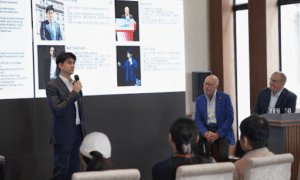Most IT transformations begin with a deadline. Srinivas Sandiri starts with a question: What is the human cost of getting this wrong?
Srinivas has led high-stakes technology initiatives across environmental services, utilities, supplier diversity, and finance-related operations for over two decades. While others rush toward tools and timelines, his approach begins with something more fundamental: trust. His belief is simple yet powerful: architecture isn’t just a framework for systems—it’s a commitment to the people it serves.
Srinivas envisions solutions that adapt, evolve, and anticipate in an industry often anchored in process adherence and regulatory frameworks. He integrates AI-driven operations, cloud-native design, and deeply embedded governance to build digital ecosystems that don’t just function—they foster confidence. These ecosystems are resilient by design and human-aware by default.
Where others scale fast and hope for control later, Srinivas embeds governance early. Where some chase AI trends, he demands transparency, traceability, and alignment with real-world value. This measured, visionary approach has earned him recognition as a trusted transformation leader in complex, highly regulated sectors.

Srinivas Sandiri
From Code to Contracts: Srinivas’s Evolution from Engineer to Strategist
Srinivas’s journey from software engineer to enterprise strategist was shaped by a defining realization: digital delivery without architectural foresight is unsustainable. “Architecture,” he says, “isn’t a diagram—it’s a contract between business goals and system behavior.”
Early in his career, Srinivas played a pivotal role in building scalable cloud solutions to support supplier diversity and ESG compliance across highly regulated sectors. These experiences exposed him to the fragility of systems when faced with evolving audit requirements and compliance pressures. Rather than reinforcing rigid structures, he adopted adaptable design thinking—engineering platforms that can grow with business and regulatory needs.
A defining example of this mindset was his leadership in modernizing a large-scale customer experience ecosystem serving millions of users. Confronted with legacy constraints, fragmented data, and stringent SOX and GDPR requirements, Srinivas embedded metadata governance, traceability, and least-privilege access into the platform’s core architecture. The result was a system architected for adaptability and trust—enhancing the customer experience through responsive design while strengthening compliance, operational agility, and enterprise-wide data confidence.
This shift—reframing compliance as a foundational design principle— has become a hallmark of Srinivas’s methodology. It’s the perspective that elevated him from implementation roles to driving enterprise transformation, building systems that are resilient, adaptable, and strategically aligned from the ground up.
Automation as Architecture: Structuring AI for Scale and Trust
For Srinivas, automation is not just about efficiency—it’s about resilience, trust, and sustained business impact. Rather than deploying tools ad hoc, he applies an architectural lens to automation, ensuring that systems perform, maintain, and scale effectively.
He developed a three-layer model to guide AI deployment in large organizations:
1) Operational Readiness
Automation begins with aligning people and processes. Srinivas focuses on dependency mapping, cultural blockers, and goal alignment across departments—laying the groundwork for AI to land and scale effectively.
2) Automation Layering
Initial AI implementations focus on confidence-building use cases, such as support ticket routing, workflow triage, and task automation. From there, logic is layered to evolve into intelligent systems that learn and improve with every interaction.
3) Governance and Security
Security is not an afterthought. Srinivas integrates policy controls, audit trails, and real-time monitoring from the outset, ensuring systems are compliant, secure, and transparent.
This method has delivered measurable results: double-digit reductions in resolution time, decreased manual intervention, and improved audit readiness. By treating automation as architecture—not tooling—Srinivas turns AI into a strategic asset rather than a tactical experiment.
“Scalable automation doesn’t just run efficiently,” he notes. “It runs with integrity.”
Designing with Empathy: Platforms That Understand and Adapt
Srinivas’s customer-centric philosophy is rooted not in interfaces but in infrastructure. “Great experiences,” he says, “begin long before a user sees a screen.” For him, platform intelligence is defined by how well systems interpret signals, automate responses, and align across business functions.
In one initiative, he transformed a high-volume support platform struggling with fragmented case handling and inconsistent resolution pathways. Rather than applying a surface-level patch, Srinivas redesigned the system’s core, integrating conversational AI, predictive case assignment, and backend data harmonization across support, sales, and marketing.
This overhaul didn’t just cut resolution time by 30%. It also provided teams with unified visibility into customer needs and behavior, transforming fragmented interactions into coordinated responses. The result was a support ecosystem that felt intuitive, adaptive, and human.
The redesign transformed internal perception—from reactive case handling to a system that anticipates intent and drives coordinated outcomes.
Srinivas’s ambition is not just to build functional systems—but platforms that learn, empathize, and continually elevate the customer experience.
Strategic AI Innovation: Turning Risk Into Enterprise Advantage
Srinivas thrives under pressure. Whether navigating regulatory constraints, legacy complexity, or cultural resistance to change, he transforms friction into fuel for architectural growth.
A recent initiative involved introducing generative AI into a conservative business unit concerned about reputational and security risks: instead of pitching possibilities, Srinivas led a strategically designed pilot anchored in clear KPIs—accelerating case resolution, enforcing robust governance, and delivering transparent, explainable AI outcomes. The initiative surpassed expectations, built executive trust, and transformed initial caution into broad organizational support for responsible AI adoption.
His transformation approach includes:
- Strategic Phasing: Rolling out innovation in calibrated phases to minimize disruption
- Empathy by Metric: Evaluating outcomes through the lens of both operational and end-user experience value
- Platform Interoperability: Orchestrating ERP, CRM, and data platforms under consistent governance
For Srinivas, risk isn’t a constraint—it’s design guidance. His leadership enables innovation to scale securely, responsibly, and with lasting impact.
Future-Ready Systems: Auditability, Resilience, and AI
Today, Srinivas focuses on embedding AI into enterprise platforms with an emphasis on auditability, transparency, and adaptability. His initiatives span intelligent service orchestration, field operations optimization, and AI-powered marketing precision.
What sets him apart isn’t just early adoption—it’s architectural accountability. He designs systems that are explainable by design, with built-in traceability and resilience to evolving business and compliance needs.
With over 17 Salesforce certifications, including Application Architect, System Architect, AI Specialist, and Data Cloud Consultant, Srinivas brings deep technical credibility to innovation at scale. His design philosophy is straightforward: innovate with discipline, govern from the ground up, and build for sustainable impact.
“The platforms we create,” he says, “must remain defensible and dependable well into the future. That’s the real test of leadership.”
A Blueprint for Digital-First Leadership
Srinivas Sandiri’s career stands as a blueprint for sustainable, purpose-driven innovation. His leadership offers a model for navigating complex, high-stakes transformation:
- Treat compliance as a catalyst for design—not a constraint
- Deliver AI with accountability—not just speed
- Align platforms with outcomes—not just features
- Center transformation around trust—not only performance
For Srinivas, the future isn’t defined by the flashiest tools or fastest deployments. It’s about building digital ecosystems that listen, adapt, and evolve—in step with the people and organizations they serve.
And that’s exactly what he continues to build—one system, one insight, one breakthrough at a time.































